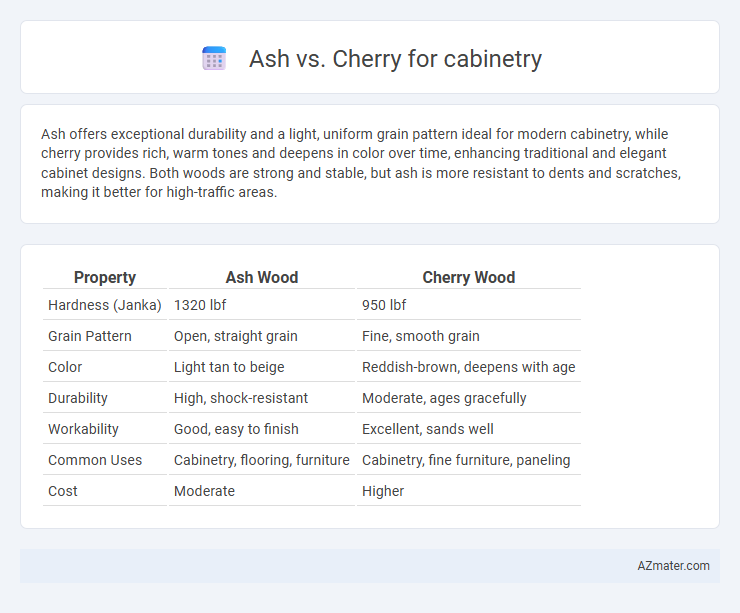Ash offers exceptional durability and a light, uniform grain pattern ideal for modern cabinetry, while cherry provides rich, warm tones and deepens in color over time, enhancing traditional and elegant cabinet designs. Both woods are strong and stable, but ash is more resistant to dents and scratches, making it better for high-traffic areas.
Table of Comparison
| Property | Ash Wood | Cherry Wood |
|---|---|---|
| Hardness (Janka) | 1320 lbf | 950 lbf |
| Grain Pattern | Open, straight grain | Fine, smooth grain |
| Color | Light tan to beige | Reddish-brown, deepens with age |
| Durability | High, shock-resistant | Moderate, ages gracefully |
| Workability | Good, easy to finish | Excellent, sands well |
| Common Uses | Cabinetry, flooring, furniture | Cabinetry, fine furniture, paneling |
| Cost | Moderate | Higher |
Introduction to Ash and Cherry Wood for Cabinetry
Ash wood offers a light, creamy color with a pronounced grain pattern, making it a popular choice for cabinetry that emphasizes natural beauty and durability. Cherry wood, known for its rich reddish hue and smooth texture, deepens in color over time, adding warmth and elegance to cabinetry designs. Both woods provide excellent strength and workability, ideal for creating long-lasting, stylish cabinets.
Key Differences Between Ash and Cherry Wood
Ash wood features a light color with a straight grain and high durability, making it ideal for modern cabinetry seeking a bright, airy appearance. Cherry wood offers a rich, reddish-brown hue that deepens with age and a fine, smooth grain, providing a classic, warm aesthetic for traditional cabinets. Both woods have excellent hardness and workability, but Ash tends to resist dents better, while Cherry develops a distinctive patina over time.
Appearance: Color, Grain, and Texture Comparison
Ash cabinetry features a light, creamy color with prominent, straight grain patterns that create a bold and rustic appearance, while cherry wood boasts a rich reddish-brown hue that deepens with age, offering a warm and elegant look. The texture of ash is coarse with open pores, providing a more textured and natural feel, contrasted by cherry's smooth surface and tighter grain that lends itself to refined and polished finishes. Both woods showcase distinct aesthetics ideal for different design preferences, with ash emphasizing brightness and pronounced grain, and cherry highlighting warmth and subtle sophistication.
Durability and Hardness of Ash vs Cherry
Ash wood boasts exceptional durability and hardness, with a Janka hardness rating of approximately 1,320, making it highly resistant to dents and wear for cabinetry. Cherry wood, while slightly less hard with a Janka rating around 995, offers excellent durability with a smooth, fine grain that ages beautifully over time. Ash is ideal for high-traffic cabinetry due to its robust strength, whereas cherry combines moderate hardness with elegant aging, balancing durability and aesthetic appeal.
Workability and Ease of Finishing
Ash wood exhibits excellent workability due to its straight grain and consistent texture, making it ideal for cabinetry that requires precise cuts and detailed shaping. Cherry wood, while slightly harder to work with because of its fine, close grain, responds exceptionally well to sanding and staining, resulting in a smooth, luxurious finish. Both woods offer ease of finishing, but cherry's natural oils enhance stain absorption, providing a rich, warm patina that deepens over time.
Cost and Availability of Ash and Cherry Cabinets
Ash cabinets offer a cost-effective option with moderate pricing due to the abundant availability of ash wood, making them popular for budget-conscious homeowners. Cherry cabinets tend to be more expensive, as cherry wood is less abundant and prized for its rich color and smooth grain, increasing both material and manufacturing costs. Availability of ash wood is widespread across North America, ensuring steady supply, whereas cherry wood is more limited, often leading to longer lead times and higher retail prices.
Maintenance Requirements and Longevity
Ash cabinetry offers high durability and is resistant to dents and scratches, requiring minimal maintenance such as regular dusting and occasional polishing to preserve its natural grain. Cherry wood, known for its rich color and smooth finish, may need more frequent care including periodic waxing or oiling to maintain its luster and prevent surface wear. Both woods exhibit excellent longevity, with ash providing slightly better resistance to wear over time, while cherry deepens in color and character with age.
Style and Design Compatibility
Ash wood offers a light, creamy color with prominent grain patterns, making it ideal for contemporary or Scandinavian-style cabinetry that emphasizes natural textures. Cherry wood presents richer, warm reddish-brown hues that deepen over time, fitting traditional or classic designs that prioritize elegance and timelessness. Both woods provide durability and can complement various interior styles, but ash's lighter tone suits airy, modern spaces, while cherry's depth enhances warmth in cozy, classic environments.
Environmental Impact and Sustainability
Ash cabinets offer a sustainable option due to their rapid growth rate and abundant availability, resulting in lower deforestation impact compared to cherry wood. Cherry wood requires longer maturation periods, leading to slower replenishment and higher ecological footprint. Choosing ash supports responsible forestry practices and reduces carbon emissions associated with harvesting and processing.
Choosing the Right Wood: Ash or Cherry for Your Cabinets
Ash wood offers a light, creamy color with a prominent grain pattern, making it ideal for achieving a rustic or contemporary look in cabinetry. Cherry wood provides a rich, reddish-brown hue that deepens over time, adding warmth and elegance to cabinets with its smooth texture. When choosing between ash and cherry for cabinetry, consider the desired aesthetic, durability, and how the wood's color will complement your overall interior design.

Infographic: Ash vs Cherry for Cabinetry
 azmater.com
azmater.com